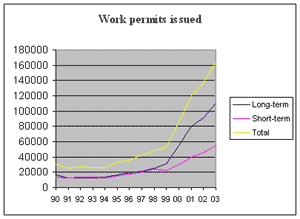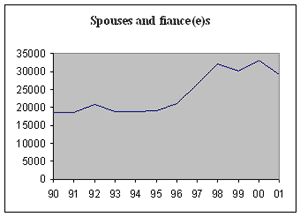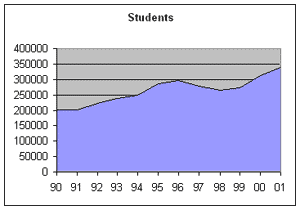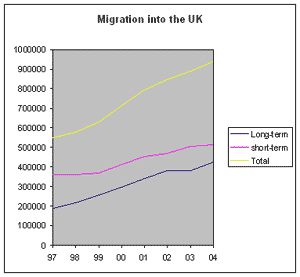19 May, 2003
Summary2. Furthermore, there is a clear inconsistency in strenuous Government efforts to reduce "asylum seekers" by 50,000 a year while increasing the number of economic migrants by some 150,000 a year[1] . The economic case for such massive immigration is, at best, extremely weak. The Government has no policy as to how large a population they envisage and are content to have migration driven purely by the "needs of the labour market"[2]. Meanwhile, the impact on society and on public services is being glossed over and public opinion is deeply concerned.
3. This paper examines both the weaknesses in "management" and the extent to which eight Government "initiatives" since 1997 have encouraged immigration. The paper looks at gross immigration as a measure of the task of assimilation and integration which our society faces. It covers those who are known to have entered Britain either with an intention of staying or with an option to stay indefinitely. The numbers who leave is not accurately known because there are no checks on the departures of foreign nationals.
4. We estimate that gross long-term migration into the UK from outside the present European Union has more than doubled from 186,000 in 1997 to 379,000 in 2002. The continued expansion of the work permit system and migration from the new members of the European Union could increase this figure further to 425,000 in 2004[3]. This will be balanced by departures (not necessarily of the same people) of about 200,000 people a year. In the continued absence of embarkation controls an accurate estimate is not possible.
5. The paper also estimates that in the same period (1997-2002) gross short-term migration from outside the EU has increased from 363,000 in 1997 to 454,000 in 2001 and we predict there will be a further increase to 515,000 in 2004[4] .
6. None of the foregoing figures take account of those who enter
the country clandestinely, nor of those who enter on student or
visitor visas and stay on illegally.
Detail
7. The following measures have been taken to either encourage or
ease the conditions for inward migration to the UK in recent years:
| a) | The work permit system has been massively expanded. Around 25,000 to 30,000 permits[5] were being issued in the early 90's compared with the Governments target of 200,000 applications in 2002[6] . | |
| b) | The rules for entry of spouses and fiancé(e)s have been relaxed. This has increased the number of people entering the country in these categories from 18,600 in 1990 to levels of around 30,000 per year in the years 1998-2001. | |
| c) | The Government has decided to allow citizens of the new accession countries to the EU freedom to work in the UK from 2004. All other EU countries with the exceptions of Ireland, Holland, Denmark and Sweden have decided to impose a transition period, of up to 7 years, until they grant this right. | |
| d) | The number of students admitted to the UK has increased from 202,000 in 1990 to 339,000 in 2001[7] . The Government now allows some students to switch immediately at graduation into work permit employment. | |
| e) | The seasonal workers scheme has been expanded for agricultural workers and extended into other sectors of the economy. | |
| f) | The focus of the working holidaymaker's scheme has been altered to encourage more entrants from the new Commonwealth and the scheme now allows people to switch into work permit employment - opening another route to long-term settlement in the UK. | |
| g) | From April 2003 the Government will be taking part in a scheme to take refugees directly from source countries into the UK. The numbers involved will be small at first but it is anticipated that the scheme will be expanded. The scheme has been started before any effective controls have been placed on the number of people seeking asylum in the UK. | |
| h) | A new programme for highly skilled migrant workers was started in 2003. The numbers entering through this route were modest (1300 in 2002) but the entry criteria under this heading have been relaxed. |
8. Some of these measures, such as the seasonal workers scheme, are not intended as entry routes to permanent settlement in the UK. However, there are no checks whatsoever on who has left the country and little or no checking of the residence status of people within these schemes. It is highly likely therefore that significant numbers of people with temporary permission to enter the country will overstay and will not be detected. The following paragraphs examine each measure in turn.
9. The work permit system [8]
Work permits are either issued on a short-term (less than one
year) or a long-term (up to five years) basis. People who have been
granted long-term permits are entitled to apply for permanent settlement
after 4 years and the vast majority (over 95%) of such applications
are accepted. Overall, approximately 27% of people issued with long-term
permits seek, and are granted, settlement rights after 4 years but
with large variations depending on the country of origin - for example
only 15% of American long-term work permit holders, but 55% of long-term
work permit holders from the Indian sub-continent, seek and are
granted settlement in the UK [9].
In the early 90's between 25,000 and 30,000 work permits were issued,
split roughly 50:50 between long-term and short-term permits. At
that time the United States, Japan, Australia, New Zealand and Canada
accounted for about half the permits issued.
By 2000 the number of permits issued had grown to 85,000 of which
nearly two-thirds were long-term permits. Nearly two-thirds of all
permits were issued to citizens of third-world countries, increasing
the percentage who are likely to eventually settle permanently in
the UK. 2001 saw a further increase in work permits issued to 120,000
and 136,000 were issued in 2002.
The Government has actively encouraged this trend by simplifying
the system so that 90% of work permits are issued in one day and
by assuming for some occupations that vacancies cannot be filled
by native workers - thus lifting the requirement to advertise vacancies
in-country before making an application. They are also now writing
to small businesses to promote permits for workers from outside
the EU.
The Government has set a target of processing 200,000 work permit
applications in the financial year 2003-4. If the target is achieved
this will result in about 165,000 individual long and short-term
permits being issued [10]. 110,000
of these permits will be long-term assuming the same proportions
of long and short-term permits as in 2000.
The following graph shows the rise in the number of permits issued
since 1990:

10. Spouses and fiancé(e)s
[11]
The primary purpose rule, in effect from 1980 to 1997, was intended
to prevent marriage, particularly arranged marriages, being used
to circumvent immigration controls. In June 1997 the rule was effectively
abolished. This has opened the door to substantial and continuous
secondary immigration. As a result the number of spouses and fiancées
admitted to the UK has increased from 18,600 in 1990 to 29,100 in
2001 - an increase of over 50%. The impact of the change in the
rules can be seen in the following graph:

11. EU accession country admissions
From 1st May 2004 eight countries from Eastern Europe [12]
plus Malta and Cyprus will join the EU. With the exception of Malta
and Cyprus their peoples will not, however, be given the immediate
right to work in the existing 15 EU countries. Instead they will
have to wait up to 7 years to automatically acquire this right,
although individual EU countries may confer full rights at an earlier
stage. Ireland, Holland, Denmark, Sweden and Greece along with the
UK have elected to grant the right with immediate effect from 2004.
The European Commission released a report in March 2001 in which they estimated that the entry of 10 central and east European countries [13] would lead to 335,000 additional immigrants a year to the current 15 EU members. Two-thirds of these were expected to move to Germany with the next most popular destination being Austria.
A PriceWaterHouseCoopers' study in 2001 estimated that, if no immigration restrictions were in place, between 1.6 and 2.4 million people of working age would look to move from Poland, the Czech Republic and Hungary to the EU by 2006. 10% of those wanting to move from Poland and 8% of those wishing to move from the Czech Republic wanted to move to the UK [14].
At the moment, the UK Government operates a special system of passport checks at Prague Airport in order to moderate inflows of asylum seekers from the Czech Republic, most of whom are Roma. After EU accession such asylum seekers from the Czech Republic and from Slovakia will be permitted free entry into the UK.
As the UK labour market will be open whilst restrictions are still in place in all the other major EU countries, it seems likely that a higher proportion will seek to migrate to the UK from these countries from 2004. Our estimate is that 20% of the potential 335,000 immigrants, i.e. 67,000 people (including dependants) will move to the UK each year (i.e. double PWC's indicative levels for Poland).
The huge gap in GDP per head between the UK and the accession countries
makes it unlikely that this process will quickly reverse. These
countries do not have the climatic advantages of previous new entrants
to the EU, such as Spain and Portugal, rather the reverse.
12. Students
There has been a steady increase in the number of students admitted
to the UK from 202,000 in 1990 to 339,000 in 2001 as shown below.

Until recently students were not able to remain in the UK after
they had completed their study, although some undoubtedly stayed
illegally and some may have found legal routes to stay, such as
marriage. This has been relaxed from summer 2004 with a new entitlement
for science, technology, engineering and mathematics students to
work in the UK for 12 months following graduation.
There are no checks to ensure that students have left the UK at
the end of their period of study.
13. Seasonal workers
The long-standing Seasonal Agricultural Workers Scheme (SAWS) until
recently had an annual quota of 10,000 workers who were allowed
to work in agriculture for 6 months during the summer months. The
quota has now been expanded to 25,000 and new schemes for lower
skilled migrants will operate from May 2003 in the food processing
and hospitality sectors each with a quota of 10,000 per annum.
People on these schemes have no right to stay in the UK at the end
of their period of employment but there are no checks whatsoever
to ensure they leave the country.
14. Working holidaymakers
The working holidaymaker's scheme is a long-established scheme which
allowed holidaymakers, who were mainly from the old Commonwealth
and the United States, to work and holiday in the UK for up to 2
years. The scheme has been altered from 2003 to "make it more
responsive to labour market needs. Working holidaymakers will in
future be able to take up work in any sector, move freely between
employers, and switch into work permit employment after one year
in the UK" [15].
The scheme has therefore become another entry point for long-term
settlement into the UK.
15. Refugees direct from source countries
In the financial year 2003-4 the UK has agreed to accept 500 refugees
(from Africa) as part of a new programme whereby refugees, after
screening by the UN, are taken directly from refugee camps for resettlement
in the UK. The Government expects to increase the numbers of refugees
entering the country by this route over time.
16. Highly skilled migrants programme
The Highly Skilled Migrants Programme was introduced in 2002
to attract highly qualified and experienced migrants to the UK.
1,300 people were attracted into the UK via this route in 2002.
The scheme is to be "strengthened" from August 2003 by
"adjusting the threshold eligibility criteria, introducing
a new category for younger applicants, and taking partners' achievements
into account in assessing individual applications"
[16].
17. We estimate that the cumulative effect of these changes has been that gross long-term immigration into the UK from outside the existing EU, using our definition of a long-term migrant [17], has more than doubled in the period 1997 to 2002. There were approximately 186,000 [18] long-term migrants from outside the EU into the UK in 1997 and we estimate that this will have increased to 382,000 in 2002. Even if the Prime Minister's target for reducing the number of asylum seekers is met we estimate that long-term migration from outside the existing EU will continue to increase, to 425,000 people in 2004, driven mainly by the expansion of the work permit system and by migration from the EU 'accession countries'.
18. Similarly short-term migration of people from outside the EU has also been increasing rapidly from 363,000 in 1997 to 454,000 in 2001 and we estimate this will increase further to 515,000 in 2004 [19] driven mainly by the issue of more short-term work permits and the expansion of the seasonal workers scheme.
19. In some cases short-term migration can legally lead to longer-term migration and settlement, for example through extension of short-term work-permits to long-term ones or by switching from being a student into work-permit employment.
20.However, since there are no checks to ensure that people have
left the country at the allotted time and no reliable system to
identify those entitled to work and to benefits in the UK, short-term
migration can also very easily lead to illegal longer-term settlement.
21. The trends in long-term and short-term migration are shown
in the following graph:

22. These levels of inward migration are, of course, partially balanced
by outward flows of people. In the absence of embarkation controls
it is not possible to put accurate numbers on outflows. However,
it should be noted that net migration into the UK from outside the
EU (as measured by the International Passenger Survey) reached approximately
178,000 in 2001, without including 20,000 dependants of asylum seekers.
23. The foregoing takes no account of those who enter the country
clandestinely, nor of those who enter with visitors' visas and stay
on illegally. There are approximately 3.5 million visitors a year
from the third world and Eastern Europe.Unmanaged Migration - Appendix
Click here to PDF version
| [1] |
The expected increase in gross long-term immigration between 1997 and 2003 excluding asylum seekers - see Appendix. |
| [2] | "The overall extent to which we want to see migration into this country to assist with our economy is a decision based on the labour market at that time" - Beverley Hughes, Minister of State giving evidence to the Home Affairs Committee on 8th May 2003. |
| [3] | See Appendix. |
| [4] | See Appendix for assumptions made. |
| [5] | Source: International Migration and the U.K. |
| [6] | Source: International Migration and the UK. Target for 2003-4 announced in Budget Report 2003. |
| [7] | Source: Control of Immigration Statistics United Kingdom 2001 |
| [8] | For a full
description of the work permit system see briefing paper bulletin no. 9 |
| [9] | Based on a comparison of long-term permits issued in the period 1990 to 1996 to work-permit holders granted settlement rights in the period 1994 to 2000. Sources: Control of Immigration Statistics UK 2000; International Migration and the UK. |
| [10] |
Assumes: Out of the 200,000 approximately 20,000 will be for group workers (usually small bands) and of the remaining 180,000 8.5% of applications will be withdrawn or refused. |
| [11] | For a full description of the rules relating to spouses and fiancées - see Migration Watch UK Research Paper F - The Primary Purpose Rule |
| [12] | Hungary,
Poland, Czech Republic, Slovakia, Slovenia, Lithuania, Latvia
and Estonia |
| [13] |
The eight accession countries plus Romania and Bulgaria |
| [14] | From PWC media release 03 October 2001 |
| [15] | Budget Report 2003, Chapter 3:Meeting the Productivity Challenge |
| [16] | Budget Report 2003, Chapter 3:Meeting the Productivity Challenge |
| [17] | See appendix for a full definition. |
| [18] | See Appendix |
| [19] | See Appendix |